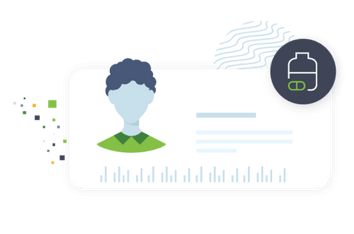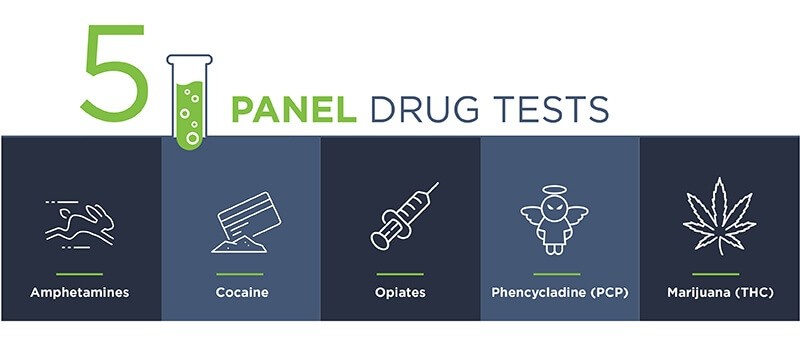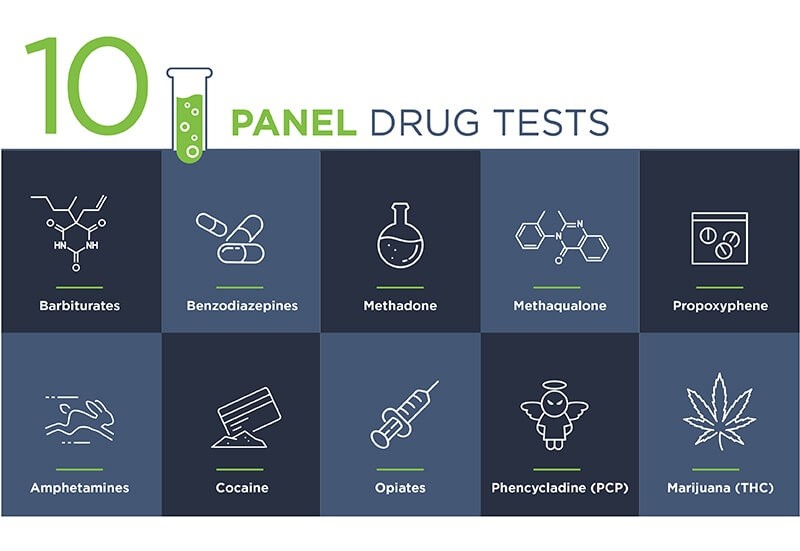Legal Marijuana Haze Lifts with GoodHire 4-Panel Employment Drug Testing
Recreational and medical marijuana laws are constantly changing. GoodHire’s 4-panel drug screening option excludes marijuana, but helps you detect other types of drug abuse.
Jim Akin
15 min read
Drug testing for job candidates and employees is increasingly common, but are not always 100% accurate.
In this blog, we’ll explain what a false positive is on a drug test; how the drug testing process works; what drugs 5-panel and 10-panel tests detect; the most common causes of a false positive; and how to dispute a false positive drug test.
Employee drug screenings have been standard procedure for decades in many industries, but the nation’s ongoing crisis of opiate and opioid abuse make it a growing focus for employers and HR professionals across the country. Reports that workers are failing workplace drug tests at the highest rates in over a decade also have many companies revisiting and updating existing policies.
U.S. News and World Report indicates that, according to reports from Quest Diagnostics, positive drug tests had hit their highest rates in more than a decade, with the states of Oregon, Maine, Vermont, Alabama, Louisiana and Massachusetts topping the list of positive results for urine-based drug tests.
Another challenge that employers now face is the legalization of marijuana for both recreational and medicinal use. As cannabis laws have changed around the US, employers are updating their drug screening protocols. Still, employers have a legitimate concern, and an obligation, to protect the health and safety of their employees and those they come into contact with.
With increased attention on testing policies, and changing guidance on how to address testing and responses to test results, comes a need for greater awareness of the strengths and weaknesses of testing procedures, including the potential for false-positive test results that can come with expansion of the type and number of drugs included in pre-employment drug screening programs. False positive drug tests are a manageable element of workplace drug-test programs.

Reasons for implementing drug testing procedures vary by employer. Some regulated industries require testing of employees, especially those with jobs that impact public safety. But whether mandatory or discretionary, virtually all drug testing addresses one or more of the following concerns:
Workplace studies have demonstrated that sound drug-free workplace policies can reduce on-the-job accidents and absenteeism and improve productivity and worker retention.
When implementing a drug-free workplace policy, it’s critical, both legally and from an employee-relations standpoint, to set clear expectations. A well-designed workplace drug policy will explain how and when testing will be conducted, and what the consequences will be for failing a test or refusing to take one. State laws and regulations may also require displaying drug-free workplace policies at worksites.
Drug testing begins with the collection of a specimen—typically urine, though saliva and hair also may be tested. Collection usually takes place at the test location. Direct observation of a subject during urine collection is generally forbidden, but technicians may accompany a subject into a restroom, listen as the specimen is collected, check its appearance and temperature, and use other methods as precautions against specimen tampering or substitution (e.g., requiring a test subject to wear a hospital gown to prevent concealment of “clean” specimens or adulterants, dying toilet water to prevent its use in diluting a specimen, etc.).
Once a specimen is collected, it is typically divided in half. One portion is tested, and the other is set aside for use in case of error or contamination, to confirm a positive test result, or to address any challenge to test findings.
Modern technology enables detection of a vast range of substances. Employers in industries where abuse of specific substances is a concern (makers and sellers of pharmaceuticals or supplements, for instance) can order custom tests for virtually any substance—if, of course, they’re willing to pay for them.
Employers must be aware, though, that certain states and municipalities (including Nevada, Maine and New York City) have passed laws restricting employers’ ability to consider an applicant or employee’s marijuana use or marijuana drug test result when making a hiring decision. New York City’s law is the strictest, prohibiting most employers from testing job applicants for marijuana altogether. Depending on the specific jurisdiction, employers in certain safety-sensitive industries may be exempt from these restrictions, so be sure to review the requirements carefully with your legal counsel.

The most common drug-testing procedure is the 5-panel test used to screen employees in industries regulated by the U.S. Department of Transportation (DOT), including interstate truck drivers, commercial rail and flight crews, and Coast Guard personnel. Often administered in conjunction with alcohol breathalyzer checks, the 5-panel tests detect the following substances:

More comprehensive 10-panel tests are gaining popularity with employers. In addition to the substances included in the 5-panel test, the 10-panel test detects five commonly abused prescription drugs:
Additional panel tests can be ordered at many labs to test for specific substances, including opioids such as Oxycontin and Oxycodone, which behave similarly to opiates in the body (and share their addictive nature), but are not detected by standard opiate tests.
Panel tests employ paper strips impregnated with antibodies that react and change color in the presence of a drug or its metabolites—substances produced when a drug breaks down in the body. The panel tests, also known as immunoassays, detect drugs much the same way home pregnancy tests change color in the presence of pregnancy-related hormones.
Panel tests are quick, effective, and easy to conduct, but they are subject to “false positives,” which appear to detect a substance that isn’t actually found in the specimen. False positives occur when a substance in the specimen is chemically similar to the target substance. These “imposter” substances can be byproducts of prescription or over-the-counter medicines, nutritional supplements, and even certain foods.
Makers of immunoassay test materials continually refine the sensitivity of test panels to reduce the likelihood of false positives. Nevertheless, the vast (and growing) number of substances, particularly prescription drugs, that can masquerade as illicit drugs or their byproducts means false positives will always be an issue with immunoassay testing.
Over-the-counter (OTC) and prescription drugs have the potential to cause unexpected results in a urine drug test, including painkillers like Advil, Motrin and Aleve; cold remedies like Benadryl; nasal decongestants like Sudafed; cough suppressants like Robitussin and Delsym; sleep aids like Unisom, Tylenol PM and Advil PM; diabetes medications like Metformin; and antidepressants like Prozac, Zoloft and Seroquel. The table below is just a sampling:
| Drug-Testing Target | Potential Source of False-Positive |
|---|---|
| Amphetamine | Cold remedies, hay fever remedies, nasal decongestants, diet pills, fluoxetine (Prozac), methylphenidate (Ritalin), bupropion (Wellbutrin), beta blockers (blood-pressure remedies) |
| Barbiturates | Sleep aids, ibuprofen (Motrin/Advil), naproxen sodium (Aleve) |
| Benzodiazepines | Ibuprofen (Motrin/Advil), sertraline (Zoloft) |
| Cocaine | Coca tea |
| Marijuana | Ibuprofen (Motrin/Advil), hemp food products |
| Methadone | Quetiopine (Seroquel) |
| Opiates/morphine | Poppy seeds (no longer an issue with latest generation of panel tests) |
| Phencycladine (PCP) | Antihistamines, dextromethorphan (cough suppressant), ibuprofen (Motrin/Advil), diphenhydramine (Benadryl) |
To safeguard against false positives, drug testing labs re-test specimens that return positive panel-tests to rule out the possibility of a false positive. The confirmation tests use testing methods far more sensitive than panel tests—typically gas chromatography–mass spectrometry (GC-MS) or high performance liquid chromatography (HPLC).
These test methods are extremely precise and can distinguish between target substances and chemical imposters that can fool panel tests.
A medical research officer (MRO) is a physician with expertise in substance abuse and drug testing. At a drug test lab, the MRO is responsible for reviewing all test results, ensuring that specimens are handled securely from the time of collection through the testing process, flagging any indication of specimen tampering or adulteration, and documenting all testing procedures.
In the case of a positive test result, the MRO may contact the test subject to check on any prescription medications, nutritional supplements, or over-the-counter medications they may be taking. In light of this information and the results of a GC-MS or HPLC confirmation test, the MRO can declare an accurate positive test result “false” if it detects a medically legitimate drug.
Finally, the MRO makes a final certification as to whether the individual being tested passes or fails. Results are typically returned to the employer within one to two business days. Employers conducting in-house testing will need to hire or contract with a trained MRO to ensure all testing procedures are ironclad and can withstand any legal challenges.
In cases where an employee or job candidate disputes a positive test result, their recourse varies from state to state. Unionized worksites may file grievances on behalf of an employee. In some jurisdictions, employers may give them the option of repeating the test using the portion of the original specimen that was set aside after collection. In some jurisdictions, the individual may have to pay for the second test procedure themselves.
Note that companies with 15 or more employees are subject to the Americans with Disabilities Act (ADA), which includes some addictions among the conditions for which employers must provide reasonable accommodations. Before drug-testing employees who are subject to the ADA, employers should be prepared to offer any required accommodations, which may include granting leave time for employees pursuing counseling or rehab.
As long as these requirements are met, the combined safeguards of a certified testing lab, verification of positive panel-test results with GC-MS or HPLC testing, and oversight by a qualified MRO make workplace drug testing highly reliable—and defensible in the event of any legal challenges.
False-positives are par for the course with workplace drug testing, but a well-designed and implemented testing policy can minimize their impact on drug-free workplaces.

The resources provided here are for educational purposes only and do not constitute legal advice. We advise you to consult your own counsel if you have legal questions related to your specific practices and compliance with applicable laws.
Follow Me
Jim Akin is a Connecticut-based freelance writer and editor with experience in employee relations, media relations, and social-media outreach. He has produced content and managed internal communications, business-to-business outreach, and consumer-focused campaigns for clients including Experian, VantageScore Solutions, Pitney Bowes, Medtronic, Microsoft, and Coca-Cola.
Recreational and medical marijuana laws are constantly changing. GoodHire’s 4-panel drug screening option excludes marijuana, but helps you detect other types of drug abuse.
In this 2-minute compliance video, Elizabeth McLean, an expert in the background screening legal landscape and General Counsel at GoodHire, shares tips to help you stay up to date on marijuana laws and drug screening policies.